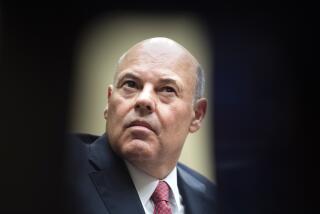Postal Service Must Deliver
The post office delivers 689 million pieces of mail per day, and letter carriers each haul 42 tons per year. Most Americans--98%--continue to pay their bills by mail. Yet those vital services are jeopardized by the Postal Service’s shaky finances. The General Accounting Office has labeled the postal system “at risk,” and Postmaster General John Potter projects a deficit of $2 billion to $3 billion for 2003.
Internal reform as well as congressional legislation is urgently needed. Indeed, even as it prepares to raise rates in June, the post office will submit a blueprint “Transformation Plan” to Congress this week.
The Postal Service courageously continued its work last fall despite suffering two deaths from anthrax and the threat of further employee contamination. In addition, the service, through no fault of its own, has had major difficulties stemming from the recession. The fundamental problem, however, is that the Postal Service has failed to adjust its business model to new economic realities. It assumes that increasing mail volume and rate increases can cover its costs. But no matter how much it raises rates, it drowns in red ink.
Its mail volumes have been declining in recent years, and terrorism exacerbated the trend--mail was down 4.9% last quarter. The overarching cause is both the rise of the Internet and what the post office has always counted on to rescue it--steady rate increases, particularly in first-class mail.
Since rate increases are not enough, the service must cut costs. Despite investing billions over the past decade in automation and information technology, it continues to struggle to increase productivity, which has increased by only 11% over the past three decades, according to the General Accounting Office. One hopeful sign is that the Postal Service plans to implement a computer system that would allow it to track the efficacy of new productivity measures.
But in the end, only Congress has the muscle to transform the postal system. Among the changes that the House Government Reform Committee should consider is ending the mandate that the Post Service is not supposed to make a profit; currently, there is little incentive to cut costs. It also needs to give the service the flexibility to raise and lower rates quickly so that it can compete more effectively with competitors such as FedEx. Right now, the post office can’t even lower rates enough to grab contracts from federal agencies. But perhaps the most contentious issue will be dealing with the postal unions, which are leery of pay incentive programs and closing superfluous mail centers.
So volatile are these issues that the General Accounting Office has recommended that something similar to the military base-closing commission be created to give Congress political cover. If the service’s own Transformation Plan calls for some version of these measures, as seems likely, Congress should pay attention. As the Postal Service flounders, it’s up to Congress to deliver.
More to Read
Inside the business of entertainment
The Wide Shot brings you news, analysis and insights on everything from streaming wars to production — and what it all means for the future.
You may occasionally receive promotional content from the Los Angeles Times.










